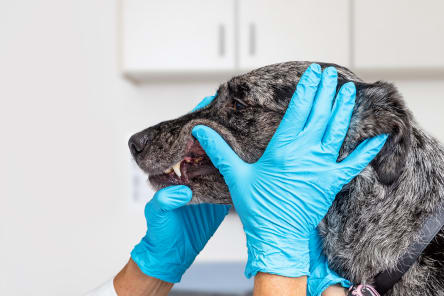Periodontal Disease in Dogs
Periodontitis bacteria can silently invade your dog’s mouth and infect the oral cavity. Typically, no signs or symptoms will appear until periodontal disease is in its advanced stages. That said, gum disease can cause gum erosion, chronic pain and loss of teeth and bone. Structures that support the teeth can also be weakened or lost.
For dogs (similar to humans), food and bacteria particles naturally accumulate along the gum line. If they are not regularly brushed away, plaque can develop and harden into tartar — also referred to as calculus. This leads to inflammation and irritation of the gum line and surrounding areas. This condition is called gingivitis and is the first stage of gum disease.

What are symptoms of periodontal disease in dogs?
At Westport Veterinary Associates, we look for these hallmark symptoms of canine periodontitis during annual dental cleanings and exams. You can also check for them at home:
- Excessive drooling
- Inflamed or bleeding gums
- Blood in water or on chew toys
- Discolored teeth (yellow or brown)
- Favoring one side of the mouth when chewing
- Loose or missing teeth
- Decrease in appetite
- Bad breath (halitosis)
- “Ropey” or bloody saliva
- Irritability
- Weight loss
By the time pet parents or veterinarians see signs of advanced periodontitis, your dog may be suffering from significant chronic pain. If this is the case, pets tend to instinctively self-isolate to avoid showing weakness to predators.
Unfortunately, your dog’s mouth isn’t the only area that will be impacted by periodontal disease. The condition can result in issues with major organs in the body. Since bacteria can enter the blood stream and surround the heart, this can also lead to heart disease.
What causes periodontal disease?
Bacteria can collect in your dog’s mouth, develop into plaque and combine with other minerals. After it has hardened (usually within two to three days), calculus develops on the teeth and becomes more difficult to scrape away.
As the immune system fights the buildup of bacteria, reactions such as inflamed gums and more obvious signs of gum disease appear.
Poor nutrition and diet can also contribute to the development of periodontal disease in dogs, in addition to environmental factors such as dirty toys, alignment of teeth (dogs with crowded teeth are more vulnerable to gum disease), oral hygiene and grooming habits (does your pup lick himself frequently?).
How is periodontal disease in dogs treated?
Costs of dental procedures such as teeth cleanings may vary widely depending on the level of care provided by your veterinarian, your pet’s needs, and other factors. Your pet will need to have blood work before being put under anesthesia to ensure she’s healthy enough for the medication, which can cause problems for dogs with organ diseases.
Any dental procedure should include:
- A complete set of dental radiographs
- IV catheter and IV fluids
- Pre-anesthesia blood work
- Circulating warm air to ensure patient stays warm while under anesthesia
- Endotracheal intubation, inhaled anesthetic and oxygen
- Anesthesia monitoring
- Scaling, polishing and lavage of gingival areas
- Local anesthesia such as novocaine, if any extractions are needed
- Pain medication during and after the procedure
How can I prevent my dog from getting periodontal disease?
Fortunately, we pet parents can prevent our pooches from getting periodontal disease, and the condition can be treated and reversed - if detected early.
When it comes to your dog’s oral health, don’t neglect it or procrastinate. Similar to their people, they require regular dental appointments to keep up with oral hygiene and identify any trouble spots. Your pup should see the vet at least once each year to have her oral health evaluated.
You’ll also have the chance to ask any questions you may have regarding at-home care, and find out how often your pet should come in for professional teeth cleanings (as those with issues may need to come more frequently).
Prevent issues from developing into unmanageable situations between appointments by doing a daily brushing of your dog’s teeth to prevent bacteria and plaque from getting a foothold (choose a toothpaste made specially for dogs).
There are also dental chews, dog food and chew toys designed to address dental disease and reduce tartar development. But fair warning: don’t try to replace brushing with these - think of them as an add-on to regular oral care). If you notice inflamed or swollen gums, missing teeth or even appetite changes, book an appointment immediately.
Note: The advice provided in this post is intended for informational purposes and does not constitute medical advice regarding pets. For an accurate diagnosis of your pet's condition, please make an appointment with your vet.
